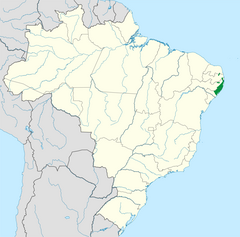Pernambuco coastal forests
| Pernambuco coastal forests | |
|---|---|

|
|
 |
|
| Ecology | |
| Biome | Atlantic Forest |
| Borders | Pernambuco interior forests, Southern Atlantic mangroves and Caatinga |
| Bird species | 407 |
| Mammal species | 122 |
| Geography | |
| Area | 17,612 km2 (6,800 sq mi) |
| Country |
|
| States | Pernambuco, Alagoas and Paraíba |
| Conservation | |
| Conservation status | Critical/Endangered |
| Habitat loss | 96% |
| Protected | 0.49% |
The Pernambuco coastal forests is an ecoregion of the Tropical moist broadleaf forests Biome, and the South American Atlantic Forest biome. It is located in northeastern Brazil.
The Pernambuco coastal forests occupy an 80 km-wide strip along the Atlantic coast of northeastern Brazil in the states of Pernambuco and Alagoas. The forests extend from near sea level to 600–800 metres (2,000–2,600 ft) in elevation, on the windward slopes of the Borborema Plateau.
The Goiana River of Pernambuco marks the forests' northern extent, and the Mundaú River of Alagoas the southern extent.
The ecoregion is bounded on the east by the Atlantic Ocean and the coastal Atlantic Coast restingas forests and Rio Piranhas mangroves. To the east, the forests transition to the drier Pernambuco interior forests and Caatinga.
The ecoregion has a tropical climate with annual rainfall ranging from 1,750 to 2,000 mm. There is a dry period from October through January.
The four-tiered evergreen Atlantic moist forests are the predominant vegetation type.
The ecoregion is an endemic bird area that harbors 13 threatened species of birds. It also harbors the last populations of the red-handed howler monkey (Alouatta belzebul) and blond capuchin (Sapajus flavius) in the Atlantic Forests.
Coastal forests in Pernambuco have a long history of deforestation. The first cycle of destruction was due to "Pau-brasil" (Caesalpinia echinata) extraction. After the extraction of Pau-brasil, through the mid-20th century, the sugarcane industry was mainly responsible for the forest clearing.
...
Wikipedia
